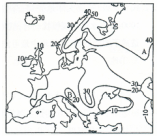阅读短文,用括号中的动词的适当形式填空,使短文意思完整、通顺。

In some science fiction movies, people in the future have their own robots. They are just like humans.
These robots 1______(use) by the people to do the? housework and the most unpleasant jobs. Some
scientists 2______(mink) that there will be such robots in the future. However, they agree it may take
hundreds of years.Now scientists 3______ (try) to make robots look like people and do the same thing as
us. Over the years, Japanese companies 4______(make) robots walk and dance already.
But scientist James White 5______(disagree). He thinks that it will be difficult for a robot to do the same
thing as a person. Once he gave us an example. It was easy for a child to wake up while he 6______(sleep)
and know where he was, but robots couldn't do this. But other scientists disagree. They think that robots
7______(be) able 10 talk to people in 25 to 50 years. Scientists are not just trying to make robots look like
people. Several years ago, some robots 8______(invent). Those robots looked like huge arms. They did the
simple jobs over and over again. People would not like to do such jobs and would get bored.
In the future, new robots will have many shapes. Some might even look like snakes. After an earthquake,
a snake robot could help look for people under buildings. That may not seem possible now, but computers
and space rockets 9______(seem) impossible a hundred years ago. We don't know what 10______(happen)
in the future. Let's wait!


